
views
Preparing the Surface for Caulking

Remove any old caulk. If your toilet already has a caulk seal around the base, you’ll want to remove it rather than apply caulk directly over it. You can find dedicated caulk removal tools in home improvement stores. Run this tool along the joint between the toilet and the floor to scrape out any old caulk. If you don’t have a caulk removal tool handy, you can also use a utility or razor knife to loosen the caulk at one end. Aim to pull it up in 1 long strip. You can make an old caulking job easier to clean up by applying commercial caulk removers before scraping. If you do, make sure to check the product’s label to prevent any possible damage to your floors or toilet.
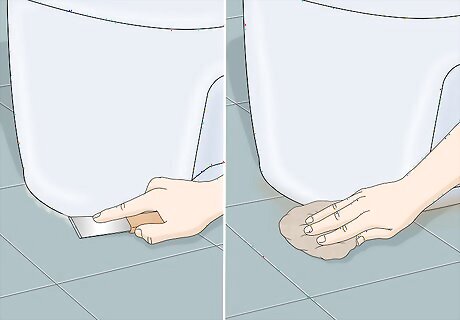
Clean the base of the toilet. After clearing the joint of any caulk, you’ll want to get the area as clean as possible. Scoop out any debris, such as paint chips, dirt or rust. Use a general purpose bathroom cleaner and a rag to clean in and around the joint. The cleaner you can get the area, the better of a seal you’ll be able to apply. After cleaning, you can wipe the area with rubbing alcohol to disinfect it. Press a tissue around the base of the toilet to check for moisture. If you find a leak, remove the toilet and replace the wax ring before continuing. If any water or other liquid gets in the joint, do your best to dry it. If you can’t quite reach it, make sure to allow enough time for it to dry properly. Overnight should be sufficient. Caulking over liquid will trap it, which can cause damage to your flooring. Ensure the toilet is even and tight to the floor. If it moves, tighten the bolts or use a shim to straighten it out. Don’t use the caulk to secure the toilet to the floor if it’s loose or uneven.
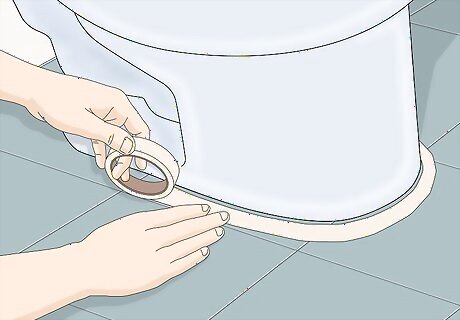
Apply masking tape to the floor. Not only will this help you get a straighter, smoother seal, but it will prevent any caulk from getting on your floors. Put masking tape on either side of the joint, one following the toilet’s base and the other along the floor. If you’re particularly worried about your caulking abilities, you can use a second strip on either side to double the width of masking tape and protect more of your floors. Since most toilets have a round base, you’ll probably have to use several strips of tape to properly follow the curve. Tear up pieces a few inches long, and apply them to the floor, following the curve of the toilet’s base. Alternatively, you can also buy masking tape that comes curved and is more flexible than typical tape. This will save you some time in taping up your floor.
Squeezing out the Caulk
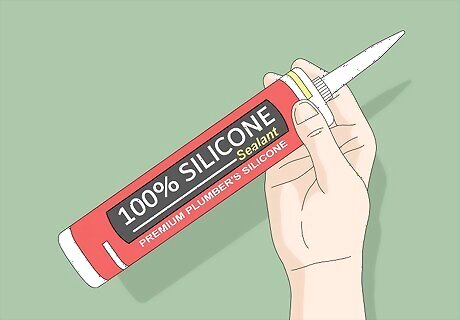
Choose 100% silicone caulk. Caulk usually comes in a tube and 100% silicone caulk is best for use on a toilet since it’s more resistant to water than other types of caulk, such as acrylic. Silicone caulk is typically a bit more expensive than other types, but that extra money will save you the problems that come with an improper seal. It’s important to match the color of your caulk to your bathroom. White usually fits most styles, but you’ll still want to give this some thought.
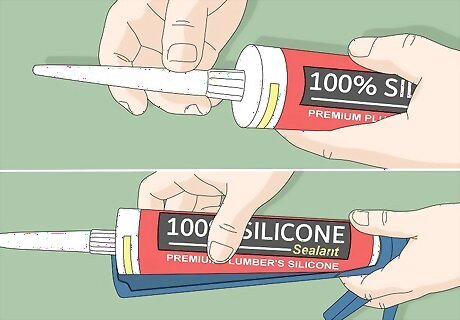
Insert the caulk tube into a caulk gun. Cut the tip off the caulk tube and puncture the end with the metal rod attached to the gun. While the tube holds the sealant, the gun is what allows you to deliver it. The main part of the gun is the plastic body, which holds the tube. The plunger is a metal pole with a flat end that runs the length of the body. At the back of the body, you’ll find a metal release, usually shaped like a trigger. Push this forward and you’ll be able to pull back the plunger. You can then insert the caulk tube and push the plunger into the back of the tube.
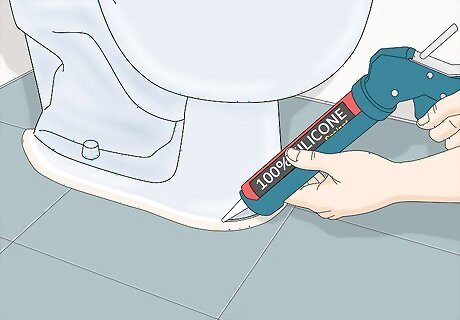
Pull the caulk gun along the joint between the toilet and floor. Pull on the trigger and keep the caulk gun at a 45-degree angle. Keep your pressure on the trigger consistent and the movement of the caulk gun slow and smooth to ensure a better seal. Use the hand not holding the gun to press the tip of the caulk tube against the joint to ensure that the caulk is pushed into the joint. Pushing the caulk rather than pulling it along will make it more difficult to create a consistent seal. You may want to have a folded up piece of cardboard available nearby to lay the caulk gun onto if you need to stop for any reason. This will prevent caulk from dribbling onto your floors. If you’re having trouble getting your caulk gun behind the toilet, try using caulk in a squeeze tube, which should allow you more flexibility.
Cleaning and Tooling the Sealant
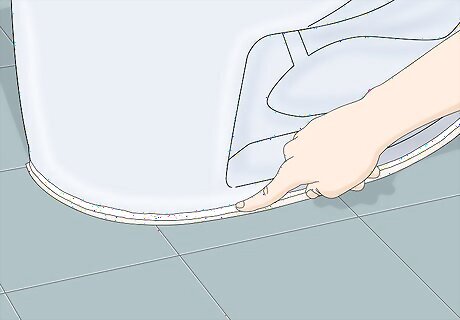
Use your finger to scoop off excess caulk. Run your finger along the caulk seal. This will push caulk deeper into the joint, sealing it more fully. You’ll also be scooping off any extra caulk, resulting in a cleaner joint. You can dip your finger in water or rubbing alcohol if you’re worried about the caulk sticking to your finger. You can discard any caulk buildup directly in the garbage. If you placed a piece of cardboard down to hold your caulk gun, you can simply collect the caulk there for disposal later. If you’re worried about dirtying your hands or irritating your skin, you should wear gloves for this step. If you're having trouble smoothing the caulk down with your finger, try pushing the bead line down with masking tape. Get it nice and smooth, then remove the tape before the caulk gets tacky. You should have a perfect caulk line without as much of a mess. You can also buy dedicated caulk finishing tools to clean up your seal, however this isn’t strictly necessary.
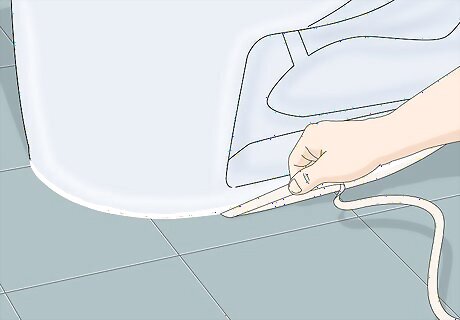
Peel off the tape. If you used masking tape, it should peel off quite easily. Pull the tape at a 45-degree angle away from you. If you got caulk on the tape, be careful as you peel it to avoid spilling the sealant on your floors. Masking tape usually shouldn’t leave any sticky residue, but if it does, you can use a product like Goo Gone to get rid of it.
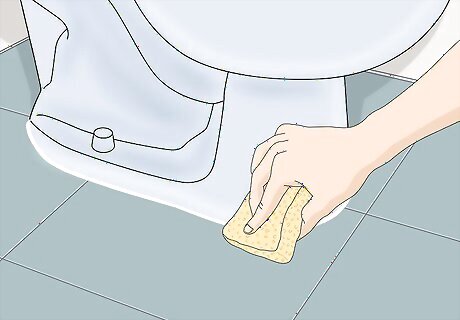
Use a damp rag or sponge to clean up around the joint. You don’t need to apply any cleaning solution to the sponge; you’re relying on its absorbency to clean up any spilled caulk. Pass a damp rag or sponge lightly around the base of the toilet, picking up any caulk around the joint. Make as many passes as you need to clean up the joint, rinsing the sponge between passes.

Allow the caulk to cure. The curing time for caulk will depend on the type you choose, so read the label carefully. In general, though, caulk needs about 24 hours to cure. Caulk hardens as it's exposed to oxygen, but if you're in a hurry, you can try pointing a fan at the caulk, or you can use a hair dryer set to low heat. This can help it cure a little faster, but don't use high heat, or it could actually make the caulk take longer to cure. If you choose fast-curing caulk, it will probably only need to cure for about 30 minutes.


















Comments
0 comment